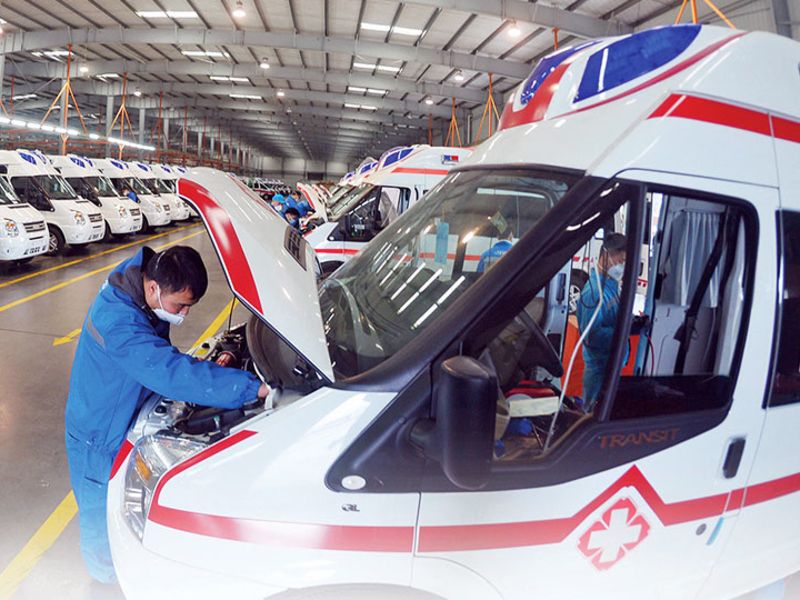
The playbooks Ford Motor Co. will use to restart assembly lines and reopen offices in Europe and the U.S. have been written largely by its team in China, which was first to be hit by — and recover from — the coronavirus outbreak.
As early as February, Ford’s salaried employees in China were sending videos to their U.S. counterparts showing how they were working from home and emotionally managing the abrupt changes, providing inspiration for colleagues who would soon be forced to do the same.
By early March, Ford China CEO Anning Chen and other executives shared what they learned about disinfecting vehicles at dealerships, creating safer factory shift patterns and even mining connected-vehicle data to predict recovery patterns.
The tutorials flowing back to Ford headquarters have provided some clarity in an unprecedented crisis that idled factories and choked off revenue.
“They’ve really helped us tremendously,” Ford COO Jim Farley told Automotive News. “There was very little playbook in ’08-’09. We didn’t know how fast the industry would come back. What’s different about this one is we have China.”
The world’s largest vehicle market was hammered by the coronavirus in January, months before Ford’s U.S. operations were affected. Today, the business there is recovering, albeit slowly.
Chen said roughly 90 percent of the unit’s salaried employees are back to work, and its assembly plants are again churning out vehicles.
First-quarter sales there were down 35 percent, but Chen said March sales industrywide had recovered to 70 percent of year-ago levels, and he expects April will reach 80 to 90 percent.
“The whole team is very, very motivated to support our global efforts,” Chen said in a phone interview. “We’ve provided everything. Much of what we have done here is being adopted or further improved and applied to the rest of the world.”
Chen, who speaks with Farley almost daily, said the process of returning to work took four to six weeks.
As the crisis wore on, the Ford China team used connected-vehicle data to monitor traffic patterns and understand which areas were still under lockdown and which were recovering. That allowed officials to predict when and where demand might return.
As Ford China started to recall workers, it implemented a number of changes.
Employees are required to wear masks at all times inside offices. Their temperature is measured each time they exit and enter a building.
All conference rooms initially were closed but have gradually reopened. Each room has a posted sign showing the maximum number of people allowed to gather inside, with spaces that used to hold 20 now limited to five.
“The work environment changed significantly, if not completely,” Chen said.
The company has remained flexible for the 10 percent of employees who continue to work from home, Chen said. Some are worried about taking public transportation, while others have to care for family members or children still home from school.
“We’re not forcing them to rush to travel,” he said.
Work looks different at Ford’s joint-venture assembly plants, too.
Chen said the company gives employees more break time and frequently changes the personal protective equipment they are required to wear. Employees receive daily health checks.
The decision to reopen plants was based on where they were located, whether cases of infections were continuing to rise and whether needed parts were available.
In total most plants were down for about five weeks, including the planned one-week closure for the Chinese New Year.
There was one exception: Xiaolan Assembly Plant, part of Ford’s joint venture with Jiangling Motors Corp., remained open through the crisis to build Transit vans that are used as ambulances throughout the country.
Ford’s China team also has provided guidance for dealers on safety measures and ways to effectively sell vehicles online.
Since the crisis started, Ford’s dealers in China have been livestreaming their showrooms on TikTok and other top social media platforms to perform virtual walk-arounds and answer customer questions. They’ve enlisted local celebrities and influencers to provide other region-specific social media content to further boost sales.
Those efforts are in addition to normal digital retail strategies the company has been using for some time. To date, Farley says one-third of the company’s sales in China happen online, compared with roughly a quarter in the U.S.
“We were developing online digital capabilities anyway,” Chen said. “This gave us a chance to accelerate and use it right away.”
If customers do want to enter showrooms, Ford’s dealers have been instructed on how to properly clean the building and the vehicles as well as how to maintain adequate social distancing.
“This gives them confidence that, even at peak times, they can deal with us without any risk,” Chen said.
He said sales and showroom traffic started to come back in mid-March, about seven weeks after the country’s initial lockdown and three weeks after Ford started to bring employees back to work.
“We don’t expect the market to come back to 100 percent anytime soon,” he said. “That will probably take several more months.”